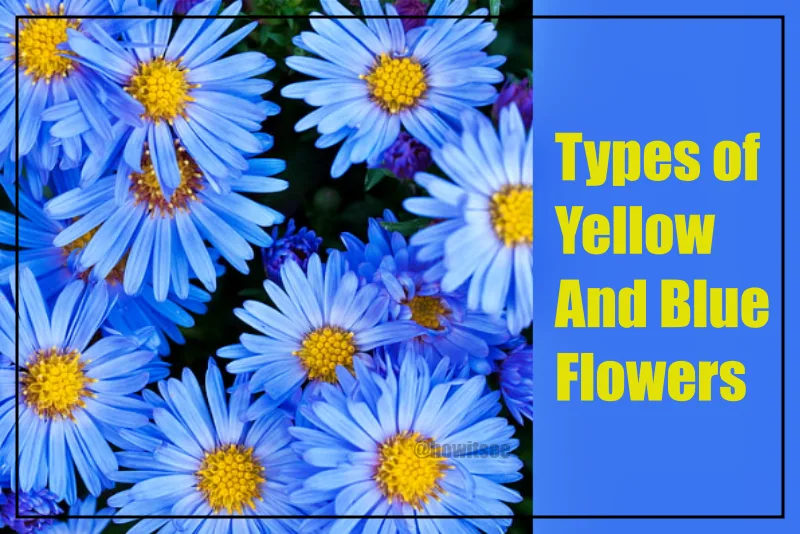Flowers are the one thing that we all admire. They add up to the beauty of nature. They are found in different colors are shapes and each one has its unique features. In the mesmerizing world of flora, flowers have long captivated human hearts with their vibrant hues and enchanting fragrances.
Among the countless shades that adorn nature’s canvas, none stand out quite like the harmonious blend of yellow and blue. These two colors, juxtaposed in their brilliance, create a visual symphony that celebrates the essence of life and the magic of the natural world.
In this article, we are going to talk about different types of blue and yellow flowers found in nature.
17 Yellow And Blue Flowers
1) Sky Blue Sun Orchid
| Scientific Name | Thelymitra jonesii |
| Geographic Origin | Cape Barren Island, Tasman Peninsula, Rocky Cape. |
| Plant Size | The petals are 6–13 mm and the stem is 80–400 mm tall |
| Identification | This flower has bluish-purple petals and the pistil has a yellow color with makes it a perfect color combination. |
Thelymitra jonesii, commonly referred to as the sky-blue sun orchid, is a kind of orchid. It bears one tall, fleshy, linear, dark green leaf and up to six tiny, light blue to azure blue blooms with darker veins. It is a rare orchid with only four recorded sites in damp coastal heath.
The flowers are pollinated by insects and bloom on warm days. Flowering occurs from September through December, and flowering is greater following the previous summer’s fire.
2) Dutch Iris
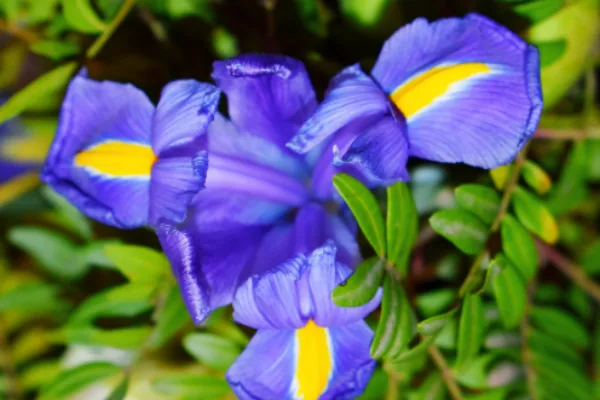
| Scientific Name | Iris × hollandica |
| Geographic Origin | Portugal, Spain, and North Africa |
| Plant Size | Reach a height of about 60 cm |
| Identification | This flower has blue petals and yellow color on its end. |
This iris has large blue to yellow to white flowers and narrow linear green leaves. They do not have any scent. They bloom primarily in the northern hemisphere from May to June, and in the southern hemisphere from September to October.
This flower has a unique color combination of blue and yellow which makes it a mesmerizing beauty of nature.
3) Swan River Daisy
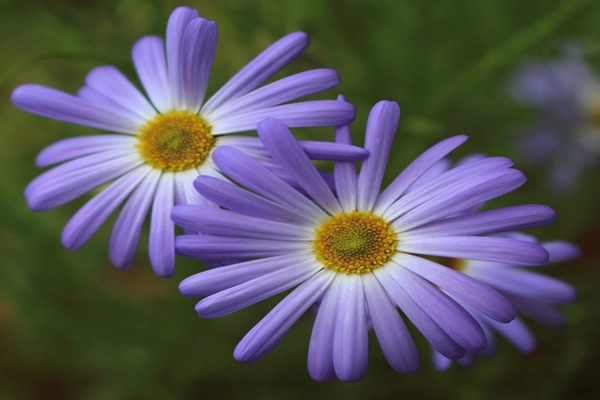
| Scientific Name | Brachyscome iberidifolia |
| Geographic Origin | Western Australia |
| Plant Size | 400 mm (15 or 16 inches) in height |
| Identification | This flower is known for its unique color combination. It has yellow stamens and bluish-purple petals. |
The Swan River daisy, Brachyscome iberidifolia, is an annual herb native to Western Australia. The species has a large range and grows out as fields.
When the Bellis daisy form and colors were discovered, they were familiar to Europeans, and they have since become a popular garden plant.
The species is hardy and versatile, so poor or sandy soils do not prevent a showy display.
Brachyscome iberidifolia leaves are entirely divided into long and thin segments. This has an excellent color combination of blue and yellow.
4) Blue Potato Vine
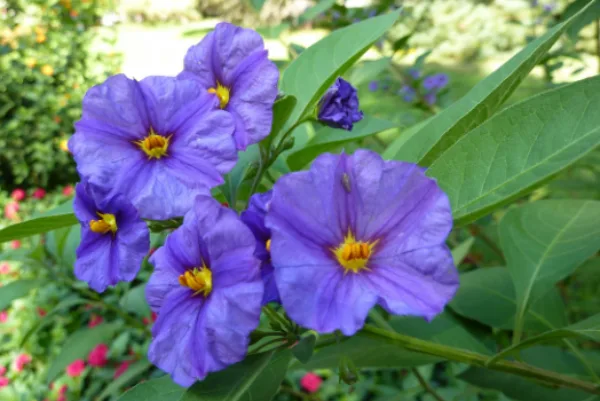
| Scientific Name | Lycianthes rantonnetii |
| Geographic Origin | Argentina and Paraguay |
| Plant Size | Grows around 8-12ft. tall |
| Identification | These are small bluish-purple flowers with yellow stamen. |
Blue potato vine scientifically known as Lycianthes rantonnetii is a species of flowers that are small and known for its beautiful purple-blue color with golden part in the center. This flower grows in full sun, moist and well-drained soil.
Blue potato vine is native to Paraguay and Argentina and grows around 8-12ft. tall in height. Though any part of this flower if eaten can cause discomfort to the body but these flower adds to the beauty of nature.
5) Blue Daisy
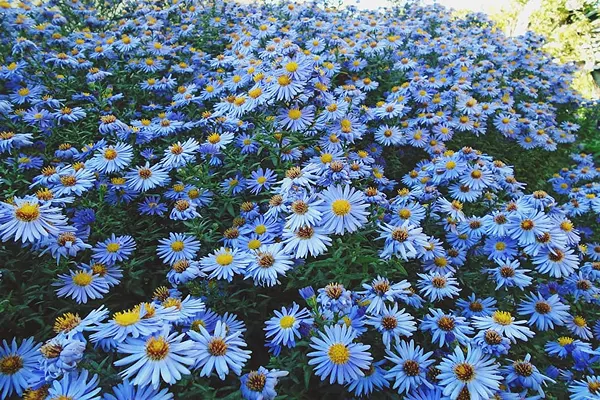
| Scientific Name | Felicia amelloides |
| Geographic Origin | the southern coast of South Africa |
| Plant Size | It grows to about 50 cm (1.6 ft) high, rarely to 1 m. |
| Identification | These are small flowers with blue petals and yellow stamen. |
Felicia amelloides, often known as blue daisy bush, is a hairy, velvety, evergreen plant in the Asteraceae family. It can be found along South Africa’s southern coast.
The leaves are placed in opposing directions along the stems and are dark green in color and elliptic in shape.
It is also grown as an ornamental plant and was brought into Europe. This flower is a beautiful combination of blue and yellow.
6) Forget-Me-Not
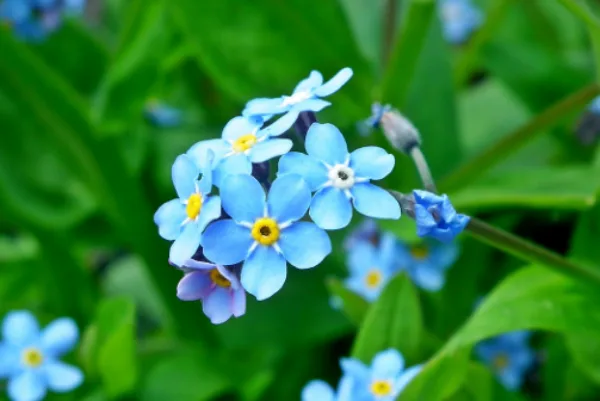
| Scientific Name | Myosotis sylvatica |
| Geographic Origin | Europe |
| Plant Size | 0.5 to 1 foot in height |
| Identification | This flower has a golden center part and blue petals. |
Forget-me-not flowers have five sepals and petals. Flowers are normally 1 cm or smaller in diameter, flat-faced, and colored blue, pink, white, or yellow with yellow centers. The flower is also a symbol of the 100th anniversary of the Armenian genocide.
The flower’s design is a black dot, which represents the history and the sorrow of the Armenian people. The light purple appendages represent the current and Armenian unity.
The five purple petals represent the future as well as the five continents to which Armenians fled.
7) Himalayan Blue Poppy
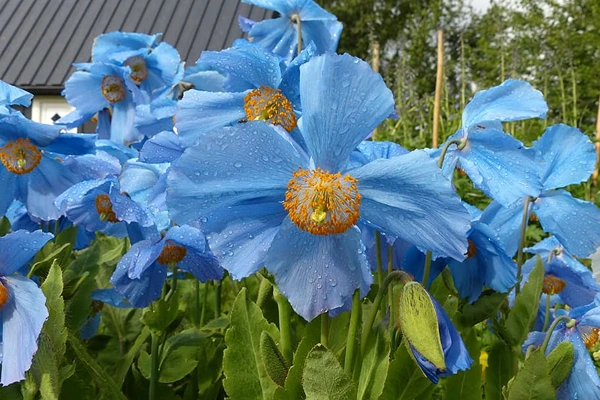
| Scientific Name | Meconopsis grandis |
| Geographic Origin | China, Bhutan, Northeast India, and Nepal |
| Plant Size | It grows to 1m in size |
| Identification | This flower has 4 large blue petals and a yellow center part. |
The Himalayan blue poppy, Meconopsis grandis, is a flowering plant in the poppy family native to China, Bhutan, North East India, and Nepal. Late in the spring, large, beautiful pure blue blooms with a visible yellow central boss appear.
The plant is valuable as an ornamental, but it is quite difficult to grow in a typical garden setting. It is perennial yet can be short-lived. It enjoys temperatures that are consistently chilly and sheltered.
8) Blue Pansies

| Scientific Name | Viola × wittrockiana |
| Geographic Origin | Europe and Western Asia |
| Plant Size | The plant may grow to 23 cm in height, |
| Identification | This flower has navy blue petals and the center part is yellow with white patterns on the petals. It is also found in other colors like red, pink, and orange. |
Garden pansy (Viola wittrockiana) is a large-flowered hybrid plant grown as a garden flower—the pansy’s link to pious humility.
The flower has two slightly overlapping upper petals, two side petals, and a single bottom petal with a little beard emerging from the center.
These petals are typically white, yellow, purple, or blue. The plant can reach a height of 23 cm and enjoys sun to varied degrees as well as well-draining soils.
9) Bush Clock vine
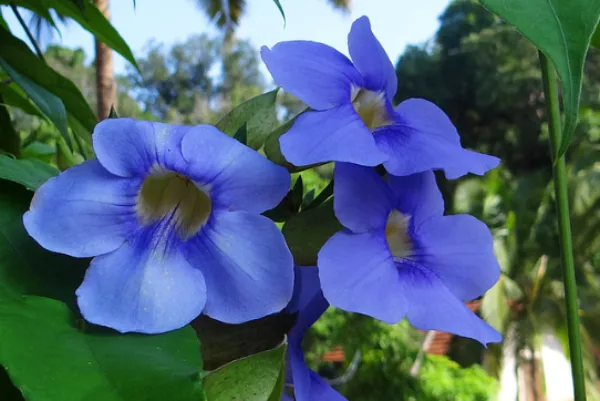
| Scientific Name | Thunbergia erecta |
| Geographic Origin | Tropical regions of West Africa |
| Plant Size | 5.0 to 7.5 cm in length, |
| Identification | This flower has a tube-like structure and the hollow part is yellow with a combination of bluish purple petals. |
Bush clock vine scientifically known as Thunbergia erecta, is a colorful, evergreen shrub in the Acanthaceae family. It is spread worldwide because of its ornamental qualities.
The plant is well-known for its upright growing habit, which can reach a height of five meters or more.
This strong shrub has a remarkable variety of pale to dark violet-purple flowers that add to its visual attractiveness and widespread popularity.
10) Nemesia
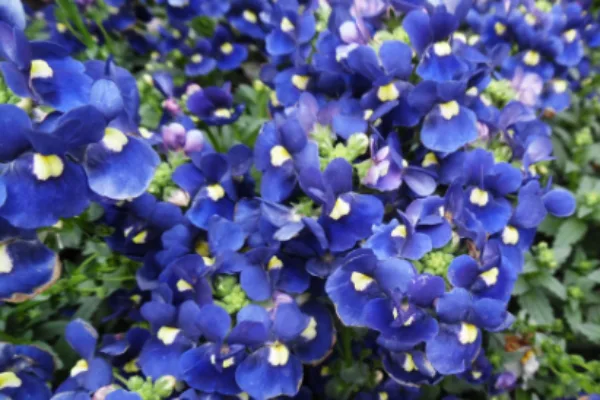
| Scientific Name | Nemesia caerulea |
| Geographic Origin | South Africa |
| Plant Size | They grow 6-12 inches tall |
| Identification | These flowers have blue petals and yellow stamen. |
Nemesia caerulea is a flower that ranges in color from blue to purple. It has several little flowers in pink, blue, and white.
The blooms have two lips, with the upper lip having four lobes and the lower lip having two lobes. The two lips have often different colors in cultivation. This has a combination of blue and yellow colors which makes it unique.
11) Blue Hibiscus Flowering Shrubs
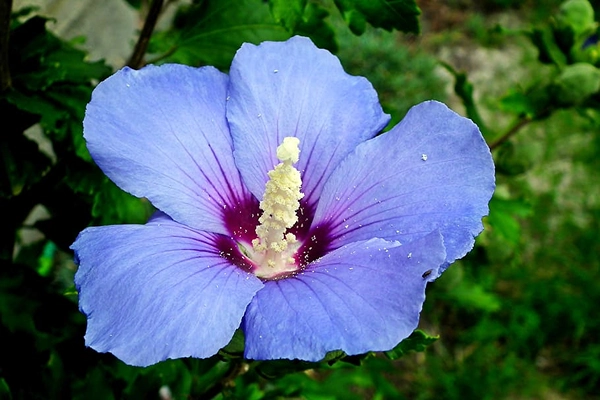
| Scientific Name | Alyogyne huegelii |
| Geographic Origin | Southwestern Australia |
| Plant Size | 4-8ft tall |
| Identification | This flower has typically four petals which are bluish-purple with a golden center part. |
Blue hibiscus flowering shrubs scientifically known as Alyogyne hueguelii a beautiful flower. It is a trumpet-shaped lilac blue to purple color flower. It grows 4-8ft. tall in height.
This flower grows in average or well-drained soils. It has a striking color and dark green leaves. Blue hibiscus is native to southwestern Australia. This flower adds to the beauty of nature.
12) Bluestar
| Scientific Name | Amsonia tabernaemontana |
| Geographic Origin | North America |
| Plant Size | 2-3 ft. tall |
| Identification | These are very small flowers with blue and sometimes white petals and have yellow color at their center. |
The common name blue star was given to the plant species Amsonia because of its delicate blue, star-shaped blossoms. The individual blooms are small, but they bloom in fluffy clusters for several weeks and make wonderful entertainment.
Blue star flowers are one of the most true blues seen in flower colors. The medium-growing plants are native to many locations in North America and are quite smooth to grow.
The airy but robust texture of the leaf makes them an excellent foil for nearly any other plant, making them extremely flexible in garden design. Their leaves become a gorgeous golden in the fall, which is an added treat.
13) Blue morning glory flower
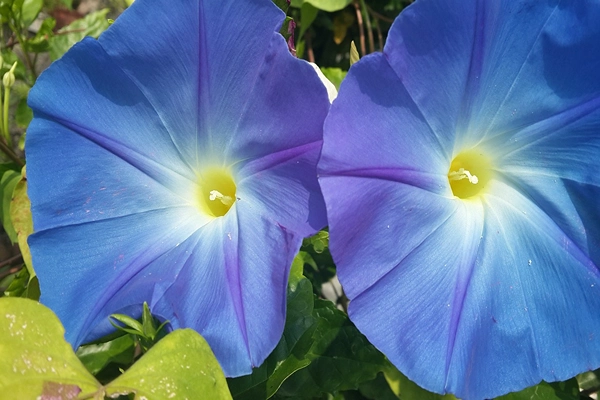
| Scientific Name | Ipomoea indica |
| Geographic Origin | Mexico and Central America |
| Plant Size | 8-10ft. in height |
| Identification | It is a funnel-like flower with navy blue petals and a yellow center. |
Ipomoea indica is a blooming plant in the Convolvulaceae family that goes by a lot of names, including blue morning glory, ocean blue morning glory, koali awa, and blue dawn flower.
From spring to autumn, it has heart-shaped or 3-lobed leaves and purple or blue funnel-shaped flowers 6-8 cm (2-3 in) in diameter.
As it grows on the bottom, the plant climbs well over other plants, walls, and slopes. Its climbing behavior allows it to compete successfully with trees and bushes.
14) Colorado blue columbine
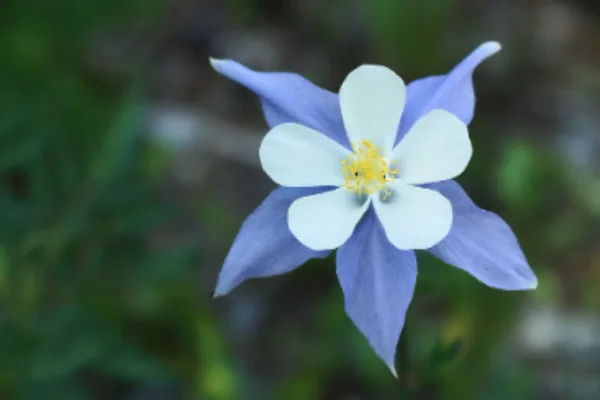
| Scientific Name | Aquilegia coerulea |
| Geographic Origin | It is the state flower of Colorado |
| Plant Size | It grows to 20–60 cm tall |
| Identification | It has a shape of 2 flowers (one inside the other). This flower is of sky blue color with a yellow center. |
Colorado blue columbine scientifically known as Aquilegia coerulea. The word cerulean is a Latin word that means “sky blue”.
They vary in color from pale blue to white, pale yellow, and pinkish; with the sepals a different shade than the petals. It grows about 20-60 cm tall.
It is a state flower of Colorado. This flower is known for its unique shape and bright colors and they add to the beauty of the nature.
15) Blue primrose flower
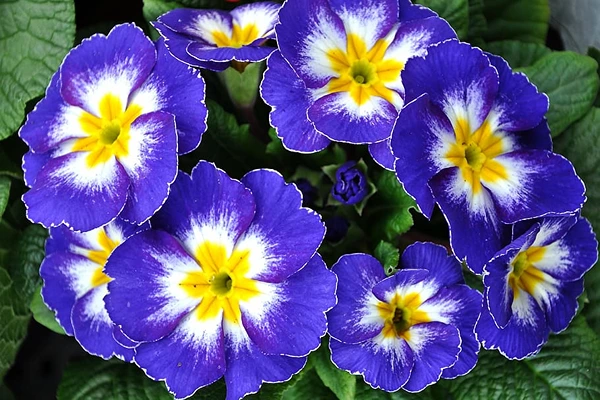
| Scientific Name | Polyanthus primrose |
| Geographic Origin | Western and southern Europe, northwest Africa, and parts of southwest Asia. |
| Plant Size | 6-8ft. tall |
| Identification | It is a blue flower with white stripes and a yellow-colored center. |
Blue primrose flower scientifically known as Polyanthus primrose is a large blue and white striped and yellow heart. It grows in humus-rich and well-drained soils.
This can reach a height of 6-8ft. tall. It requires a large blooming period from winter to spring. This flower has a unique shape and bright colors and they add to the beauty of nature.
16) Bird of Paradise
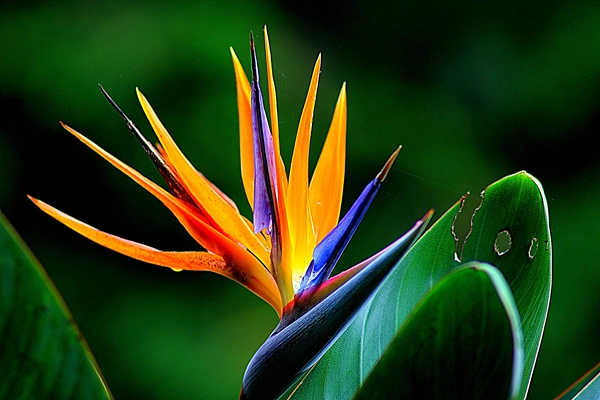
| Scientific Name | Strelitzia reginae |
| Geographic Origin | South Africa |
| Plant Size | ~3 to 5 feet in height |
| Identification | This is a yellow and blue flower that has two erect pointed petals and five stamens. |
The bird-of-paradise flower (Strelitzia reginae), often known as the crane flower, is a South African ornamental plant. Because of its lovely foliage and distinctive blossoms, the plant is grown both outdoors and as a houseplant in warm climates.
It was called after the showy forest birds known as Birds of Paradise. The leaves are blue-green with a possible red midrib.
The bloom is golden and blue with two erect pointed petals and five stamens. One primary flower bract is green with crimson edges and shaped like a boat. The fruits are capsules containing many seeds.
17) Viola tricolor
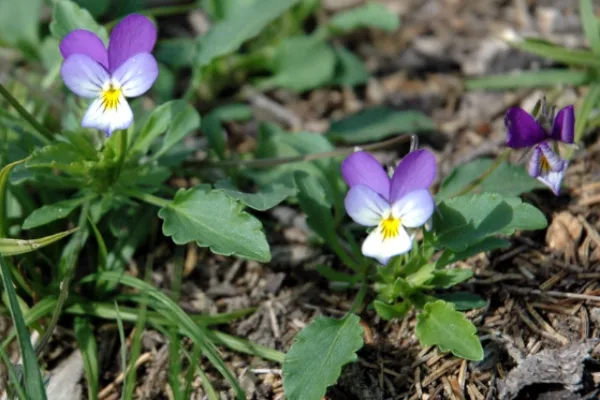
| Scientific Name | Viola tricolor |
| Geographic Origin | Europe and Western Asia |
| Plant Size | ~6 inches in height |
| Identification | This flower has navy blue petals and the center part is yellow. It is also found in other colors like red, pink, and orange. This also found in tricolor |
The garden pansy is a large-flowered hybrid plant grown as a garden flower. Viola tricolor, sometimes known as heartsease, is a wildflower native to Europe and Western Asia.
For convenience, the older term Viola tricolor var. hortensis is frequently used. Pansies are perennials, but because they are short-lived in many locations, they are sometimes produced as hardy annuals or biennials.
Hybrids are available in about every color imaginable, with many being bicolored or tricolored.
Conclusion
As we conclude our exploration of “17 Yellow and Blue Flowers,” we are left with a profound appreciation for the kaleidoscope of colors that grace our world.
Each petal, a brushstroke in nature’s masterpiece, whispers a timeless melody that resonates in the depths of our souls.
The symphony of yellow and blue blooms has taught us the value of diversity, not just in colors but in the vast array of life forms that coexist on our planet.
From the Bird of Paradise flower, gazing confidently at the sky, to the delicate forget-me-nots, symbolizing everlasting love, these flowers teach us to embrace our uniqueness and contribute to the beauty of the whole.
Also Read:

I am a person who effortlessly combines creativity, hard work, and a strong interest in nature. My writing takes you on incredible journeys where science and imagination come together. I am driven by a deep curiosity to understand the wonders of life, and dive into the details of biology with thorough research and a genuine appreciation for nature. My articles are full of vivid descriptions and fascinating facts, making the world of biology come alive. Whether I am writing articles, essays, or fiction, my work sparks curiosity and shows the incredible beauty of our natural world.
